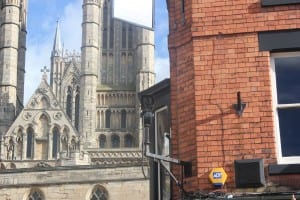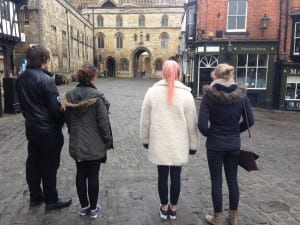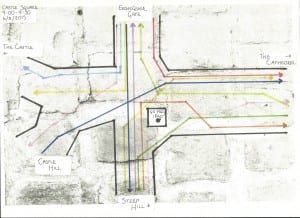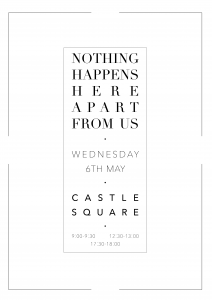The ‘Top of the Hill’ was our initial given site; as Pearson explains, ‘site specificity’ is a loose term, open for interpretation and ‘no longer a fixed location, now it is somewhere, or something constituted through social, economic, cultural and political processes’ (Pearson, 2010, p. 11). ‘Nothing Happens Here Apart From Us’ is a three part performance situated in Castle Square, Lincoln. The performance challenges various issues of the space such as; surveillance, liminal spacing and the concept of ‘us’. The performances are to be carried out at three contrasting times of the day; 9:00-9:30, 12:30-13:00 and 17:30-18:00 to an unsuspecting, accidental audience that will be the everyday users of the space.
Site Specific
Pearson describes calling site specific performance ‘that undertaken in non-theatrical spaces’ as ‘barely adequate’ (Pearson, 2010, p.66) – the introductory workshop alone demonstrated to me the accuracy of this comment, as well as the vast amount of possibilities and complexities the experimentation with ‘site’ provides.
We began by experimenting by looking at Duncan Speakman’s ‘subtle mob’ outside the LPAC Theatre and watching a clip on his sound-walk piece “As If It Were The Last Time”. Afterwards I did some further research into the development and planning of this moving piece and learnt about the possible positive effects site specific performance can have upon participants and passers-by – with one Londoner saying how it had made them feel like they were in ‘a movie’.
As the top of the hill/ or the ‘cathedral quarter’ is a location often so focused on history I felt this was an obvious and important aspect of research. In particular I looked into Jen Harvie and Dan Rebellato’s ‘Theatre and Architecture’ as it highlights how the relationship between architecture and theatre is often overlooked but for French Theatre Director Jacques Copeau ‘architecture is the most fundamental aspect of theatre’ ( p.2) As we had the possibility of performing around some grand pieces of history and architecture such as the Cathedral, the Castle etc I felt that this needed considering. Whilst researching the history of the site and walking around the Cathedral I spotted the Latin words ‘pereunt et imputantur’ carved on one of the sides of the Cathedral walls, which translated means ‘They (hours) pass away and are reckoned on (our) account. This again made me think of Speakman’s ‘As If It Were The Last Time’ and the possibility of creating a piece that involves some kind of spiritual journey or one that encaptures the history as well as just the ‘now’ of our site.
Initially, my group and I thought of creating a ghost walk, or a kind of guided tour combined with small installations of orchestrated serendipity between. However upon further research we soon got rid of this idea as we felt it wasn’t original enough and existing ghost walks around the Cathedral meant innovation of myths and stories would be difficult despite looking into the possibilities of a misguided tour.
Nothing Happens Here Apart From Us
After taking inspiration from a comment a member of our group overheard during a workshop- ‘nothing happens here apart from us’- my group and I began to discuss our interpretations of the quote and the meaning of ‘us’, as in site specific performance ‘opportunities reside in the multiple creative articulations of ‘us’, ’them and ‘there’’ (Pearson, 2010, p.19). By saying that nothing happens in the site apart from them it suggests that as a community they feel as if they simply just live, when in fact it is because of them living that the place thrives. In a space of historical importance it is easy to forget about the present, our individual importance and our collective importance. We therefore decided to rather than create a performance in our chosen site, use our site as the performance.
CCTV
To help further develop this idea my group and I tried some of Pearson’s ‘exercises towards place’; during which he asks ‘what we would have noticed if we had gone there without a camera’ (Pearson, 2011). We found ourselves particularly drawn to the CCTV camera situated above the entrance to the Magna Carta pub near the centre of the Square. We watched the camera and recorded the four main angles it took; these were, towards Steep Hill, the Cathedral, the Castle and the Exchequer Gate.
This raised an interesting discussion into the political issue of surveillance and pervasive media (any experience that uses sensors and/or mobile/wireless networks to bring you content (film, music, images, a game…) that’s sensitive to your situation), (Pervasive Media Studio, 2015). It is predicted that there is 1 camera to every 11 people in Britain, and the British Security Industry Authority estimates there are up to 59 million closed circuit television cameras in the country. (Barrett, 2011)
I found it particularly interesting that this modern phenomenon of being constantly watched is so focal in a site with such historical importance (see figure 1). The juxtaposition between the historical and the contemporary, the political and the poetic (Pearson, 2010, p.25) allowed us to begin to think of ways in which we may interpret this dynamic in our piece.
In 1980-1981 Tehching Hsieh carried out his second durational performance, entitled ‘1 year performance 1980-1981’, informally known as the ‘Time Clock Piece’, where he punched a time clock every hour on the hour for the duration of a year. The documentation of this piece has ultimately become the artwork and the photographic evidence and time cards provide a lasting existence of Hsieh’s performance. This inspired me to start experimenting with time-lapse videos and photographs; filming in the four main angles that the CCTV camera took of Castle Square, at varying times and days in order to capture as much activity as possible. With this, my group and I thought we could somehow present the videos back to the audience showing how they- the ‘us’- make the space what it is. Initially we thought of having a computer set up in the Magna Carter pub replaying these videos and our request to do this was approved.
Like Hsieh, our time lapse videos were a vital part of our process as ‘sometimes the performance will only exist through its documentation’ (Lavery, 2005) While there may be tensions between the live nature of practice and a recording of the work, documentation can be seen as a potentially dynamic and interactive process. Video, for one an example of documentation, ‘is the process of preserving and making present to see and know something that without being recorded would have been inaccessible and unavailable.’ (Reason, 2008, p.80) without our time lapse videos of the Square from the position of the CCTV it is unlikely that the public will very be able to see themselves back in this way. ‘Documentation has a place within site specific practice precisely because it explicitly presents itself in the absence of its object.’ (Kaye, 2000, p.218)
CCTV Ballet
Using feedback from our peers we were made aware of the difficulties of trying to ‘become’ the CCTV camera; however we knew we still wanted to incorporate our ideas of surveillance and constantly being watched.
Therefore we looked back at The Surveillance Camera Players, formed in New York in 1966 the group is completely distrustful of all governments and are unconditionally opposed to the installation and use of video surveillance cameras in public places. Using similar ideas my group and I tried to carry out our own ‘CCTV Ballet’ where we spent thirty-minutes ‘performing’ to the CCTV camera, following it as it changes angle and staring directly at it when it is stationary (see figure 2).
We then looked into Freedom of Information Act and emailed Lincoln City Council requesting the CCTV footage from the date and time of our ballet. Unfortunately we never received the footage, however this exercise helped us to realise that we wanted to push forward a more political message. The Surveillance Camera Players’ performances can also be seen as a type of protest to the political issues of surveillance and privacy, opposing control and authority; “The Surveillance Camera Players are not watching you. They are watching the cameras, because we have forgotten to.” (Surveillance Camera Players, 2006)
Audience
Furthermore, we decided that just simply presenting back pre-recorded footage of the site was not performative enough and could easily become tedious to an audience member, and so we got rid of the idea of having a laptop set up in the Magna Carta and began to discuss the possibilities of using a Go-pro with a live stream to an ipad or alternative screen that remains in the square and could make the piece more playful and interactive with the public and more about the present, the ‘now’, rather than just the past. By doing this, we gave our accidental audience the opportunity to be as actively involved in creating the performance as they chose, the interaction becomes a result of natural intrigue rather than forced viewing.
Another piece that helped inspire these ideas was ‘Shadowing’ by Jonathon Chomko and Matthew Rosier from the Pervasive Media Studio, I felt the piece was highly relevant as they too were trying to create a sense unity by using technology in a playful way…
“technology is often used to drive us in different directions and onto different paths. [Shadowing] stops people for a moment to think about the same old street but in a different way” (Benjie, Shadowing Trailer, 2014)
Use of the Space
Castle Square is an interesting site, it is a crossing, a liminal space with never ending possibilities of entrances and exits. The people occupying this space vary greatly; our audience can vary from tourists visiting for the first time or local residence who see these historical points of interest as ‘everyday’. We therefore began to look into crowd behaviour and the way people both use and present themselves in the space; ‘Places betwixt and between… where all actions and motives are under scrutiny.’ (Pearson, 2010, p.28)
By practising an exercise introduced to us by our tutor, ‘drifting’ or ‘meandering’ allows ‘one to become aware of suburban details and social space.’ (Jones, 2010, p.87) Whilst walking around the site I used Pearson’s ‘Models and Approaches’ chapter to study the behaviour of the people occupying the space; although ‘the site’s architecture may ‘establish a certain social code’ (T and A p.5) I wanted to focus more on the concept on liminality and journeying to different final destinations. The two models which I felt were most accurate were looking at the public as either ‘nomad’ or ‘ramblers’…
‘As a nomad: shifting across the space… using points and locations to define paths rather than places to be. The enemy of the nomad is the authority that wants to take the space and enclose it and to create fixed and well directed paths for movement.’ (Pearson, 2010, p.20)
‘As a rambler, rethinking the city as a series of flows or movements in pursuit of pleasure, moving between sites of leisure, consumption, exchange and display. Rambling as a ‘mode of movement’ which celebrates the public spaces, streets and excitement of urban life’ (Pearson, 2010, p.20/21)
We then began to make connections between the behaviour of crowds and the awareness of surveillance. Thus leading us looking into the concept of the ‘Panopticon’; a type of industrial building designed in the late 18th century. The concept of the design is to allow a single watchman to observe all inmates of an institution without the inmates being able to tell whether or not they are being watched. The significance of this concept in relation to our site is that it is impossible to know when you are being watched by the CCTV camera and its operator, and so, as a nation we have altered our behaviour in case we are.
The idea of an unseen higher power, controlling the behaviour of the people in the site is also a relevant concept due to the upcoming elections in the days following our final performance. By using a single, recording go-pro, live streaming the footage to a single ipad in our performance we are attempting to bring the ‘high powers’ into the public space, challenging capitalist ideologies of hierarchy and control.
Maps
Like the Surveillance Camera Players we decided to incorporate maps into our performance, however ours would be records of the various routes taken in the space by random members of the public. The maps in-cooperate our messages of surveillance as individually the audience are being watched and recorded, freedom as the results may show uses of the space that challenges authority and creates an impression of unity between ‘us’ as together we make the space thrive.
The background to my map was a photograph of the stone floor in Castle Square, I then used Google Maps to scale out from the site and overlay the image on top, relating back to the idea of the Panopticon and a higher being (For an example of one of my final maps see figure 3).
Evaluation
For our final performance we had two group members stood near to the entrance of the Magna Carta, in close proximity to the camera holding the live recording Go-Pro and an iPad replaying this, whilst the other three members created maps of the site and followed members of the public around, recording the routes they took.
The maps reflected the liminal space of the square, and city to be ‘consisting of endless intersecting narratives’ (Pearson, 2010, p.98) Highlighting how individual experiences of people in the space, collectively make it what it is. The Go-Pro and iPad represented the surveillance camera, constantly watching the square but making it accessible to the general public.
(For all our final maps and videos, see our Flickr page: https://www.flickr.com/photos/nothinghappenssite/)
The recordings taken from the Go Pro and iPad provide evidence of the varied reaction we got from our accidental audience; some were intrigued by the camera, others, were not keen with one lady making a passing remark to me saying how ‘everybody today is so nosey’ – an ironic comment as our performance was an attempt to make people aware of the surveillance camera in the space and how it usually goes completely ignored, perhaps this showed to us though that the connection between our attempt at unifying the site and opposing surveillance was not strong enough.
However we also received some very positive reactions as well, during the third performance a man passed asking ‘if we had been there all day’ as he had passed and seen us during the morning performance also. This worked well and helped to reinforce our message of the constant watching and presence of surveillance in our everyday lives.
The positioning of the Go Pro and iPad worked well as it remained in close proximity to the surveillance camera and being near the centre of the Square meant they were visible from all directions. We decided not to encourage audience interaction and let this happen naturally in our final performances; achieved by displaying a clear focus into what we were doing, avoiding communication with the public and if we are approached we had printed business cards ready with a link to our blog and Flickr page. I felt this worked well and made us like the silent, faceless ‘higher-powers’ controlling the surveillance of the site. Prior rehearsals in the site meant that the synchronised moving of the Go-Pro and iPad in order to avoid traffic or to follow the CCTV as it changed angles, looked very effective, causing intrigue.
The technological difficulties we experienced on the day could have been dealt with better. Although we had rehearsed in the site with them before the unpredictability of technology meant we should have had some sort of alternative plan in place. Thankfully, the majority of the recording was successful and key issues surrounding video such as shaky camera work and poor quality were avoided by maintaining a still, strict pose throughout.
To improve our piece I feel a more direct aim and through-message should have been adopted. It was difficult trying to create a performance that encaptured all the different issues and aspects of the site that we wanted; including the juxtaposition between contemporary and the historical, creating a sense of community, the possibilities of liminality and the issue of surveillance. With hind sight I feel as though we should have included our time lapse videos more into our final piece than just in the process and as a part of documentation. By using a live go-pro and pre-recorded footage we perhaps could have highlighted the space as being reliant on both its history, present and the ‘us’ for making it.
Bibliography
Auslander, P (2006) ‘The Performativity of Performance Documentation’ Vol 28, p.1-10
Das Platforms (2014) Tehching Hsieh: One Year Performance 1980-1981. [online video] Available from: https://www.youtube.com/watch?v=tvebnkjwTeU [Accessed 7 April 2015]
Harvie, J and Rebellato, D (2015) Theatre and Architecture. London: Palgrave Macmillan
Jones, Claire Blundell (2010) ‘Walking, the Western and the tumbleweed’, Visual Studies, 25: 1, p. 87-88
Kaye, N (2000) ‘Site Specific Art, Performance, Place and Documentation’, London: Routledge
Lavery, C (2005) ‘Teaching Performance Studies, 25 instructions for performance in cities’, Vol. 25, Issue 3, p.229-238
Ledger, J, Ellis, S and Wright, F.(2011) ‘The Questionof Documentation: Creative Strategies in Performance Research’, in Kershaw, B and Nicholson, H ‘Research Methods in Theatre and Performance’, Edinburgh: University Press
Pearson, M, (2010) Site Specific Performance. Basingtone: Palgrave Macmillan.
Pearson, M. (2011) Some Exercises Towards Relating Space. [online] Available from https://blackboard.lincoln.ac.uk/bbcswebdav/pid-953326-dt-content-rid-1863756_2/courses/DRA2035M-1415/Mike%20Pearson%20%203bplaceexercises.pdf
Watershed, Pervasive Media Studio (2014) Shadowing [Online] Available from http://www.watershed.co.uk/pmstudio/project/shadowing [Accessed: 8/3/2015]




